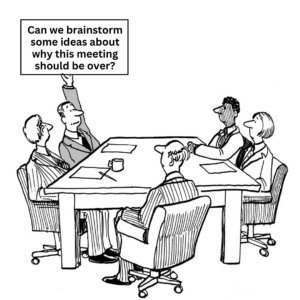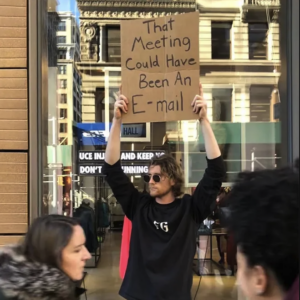This document may be printed, photocopied, and disseminated freely with attribution. All content is the property of the McCormick Center for Early Childhood Leadership.
Not-so-fun fact: 17% of employees would rather watch paint dry than attend a status meeting. 1
If staff in your program are not jumping for joy when you announce an upcoming staff meeting, don’t worry—they are in good company. In fact, many of us would rather do just about anything else than sit in a meeting, often because we perceive the meetings we are required to attend as unproductive, irrelevant, and frustrating.2 It should come as no surprise then that many meeting attendees admit they don’t actively participate in required meetings. One study, for example, found that 73% of meeting attendees reported using meeting time to do unrelated work, and 90% reported daydreaming during meetings.2 Even more worrisome is that many meeting leaders seem to have opposite perspectives and report that the meetings they lead are very productive.3 This suggests a disconnect, where leaders overestimate the effectiveness of their meetings while attendees are scrolling on their phones and daydreaming about dinner.
 My colleague Wendy Connell and I recently created a new self-paced online module for leaders called, Communication in the Workplace: Crafting Connections, Managing Meetings, and Resolving Rifts. Along with exploring communication styles and conflict resolution, the module examines how to transform meeting dread into exciting and productive opportunities for staff to feel seen and heard. To do this, we share several strategies for leading more effective meetings. In doing so, we also address a few common meeting challenges and provide strategies to combat the issues. Below is one example of a common challenge with meetings, lack of engagement and some of the strategies we share in the module to increase staff investment and participation.
My colleague Wendy Connell and I recently created a new self-paced online module for leaders called, Communication in the Workplace: Crafting Connections, Managing Meetings, and Resolving Rifts. Along with exploring communication styles and conflict resolution, the module examines how to transform meeting dread into exciting and productive opportunities for staff to feel seen and heard. To do this, we share several strategies for leading more effective meetings. In doing so, we also address a few common meeting challenges and provide strategies to combat the issues. Below is one example of a common challenge with meetings, lack of engagement and some of the strategies we share in the module to increase staff investment and participation.
LACK OF ENGAGEMENT
Both meeting attendees and leaders are frustrated by the lack of participation and engagement. Attendees don’t want to be lectured, and meeting leaders don’t want to stare out at a sea of people texting under the table or staring into the abyss. Below are four strategies to help leaders craft a meeting agenda that fosters participant engagement and sets the stage for effective and enjoyable meeting experiences.
CRAFT AN AGENDA THAT FOSTERS ENGAGEMENT3

©Seth Phillips/Dude With Sign 1
Curiosity and problem-solving are great motivators for learning. By transforming agenda topics into questions, you’re likely to capture staff’s attention and capitalize on their natural tendency to want to solve things.
Patrick Lencioni said, “The majority of meetings should be discussions that lead to decisions.” However, most of us never received formal training on conducting meetings. So, it is no surprise that many meetings cause frustration. Hopefully, the strategies listed above and the reflection questions below will help you leverage your planning efforts in ways that lead to more effective, efficient, and engaging meetings.
For more strategies on making meetings a little less miserable, as well as other topics related to communication in the early childhood workplace, check out the Communication in the Workplace module or contact PAS.BAS@nl.edu to inquire about virtual or in-person training options.
Please download the resource to access our Meeting Leader Reflection Questions.
RESOURCES AND REFERENCES
1Zetlin, M. (2015). 17 Percent of Employees Would Rather Watch Paint Dry Than Attend Meetings: Try these alternatives instead. Inc. https://www.inc.com/minda-zetlin/17-percent-of-employees-would-rather-watch-paint-dry-than-attend-team-meetings.html
2Leach, D., Rogelberg, S., Warr, P., & Burnfield, J. (2009). Perceived Meeting Effectiveness: The Role of Design Characteristics. Journal of Business and Psychology. 24. 65-76. 10.1007/s10869-009-9092-6.
3Kelton, R. & Connell, W. (2024). Communication in the Workplace: Crafting Connections, Managing Meetings, and Resolving Rifts. Center for Early Childhood Leadership, McCormick Institute, National Louis University. https://mccormickcenterelearning.nl.edu/ets/store/
4Grant, A. (Host). (2023, September 26). Why meetings suck and how to fix them. Worklife [Audio podcast]. TED. https://www.ted.com/podcasts/worklife/why-meetings-suck-and-how-to-fix-them-transcript
Robyn Kelton, M.A., is the Director of Research and Evaluation for the McCormick Institute’s Center for Early Childhood Leadership at National Louis University (NLU). In this role, Robyn oversees work related to the McCormick Center’s research interests and evaluation and quality support tools including Program Administration Scale (PAS) and Business Administration Scale for Family Child Care (BAS), the Early Childhood Work Environment Survey (ECWES), and the Administrator Role Perception Survey (ARPS). Robyn also oversees research related to the evaluation needs of the professional learning initiatives at the Center as well as the relationship between evaluation tools and program quality, workforce retention, and leadership development. Other research interests include cognitive and developmental psychology, memory development, and learning. Robyn holds a Baccalaureate degree in psychology from the University of Kansas (KU) and a Masters of Arts degree in psychology with an advanced certificate of study in organizational psychology from NLU. Robyn is currently a doctoral candidate in the brain, behavior, and quantitative science Ph.D. psychology program at KU. Prior to joining the McCormick Center in 2006, Robyn worked as a lead teacher in a kindergarten classroom for an after-school program and a lead teacher of a 4-5 year old classroom in a child care center.
Robyn.kelton@nl.edu | 847.947.5698